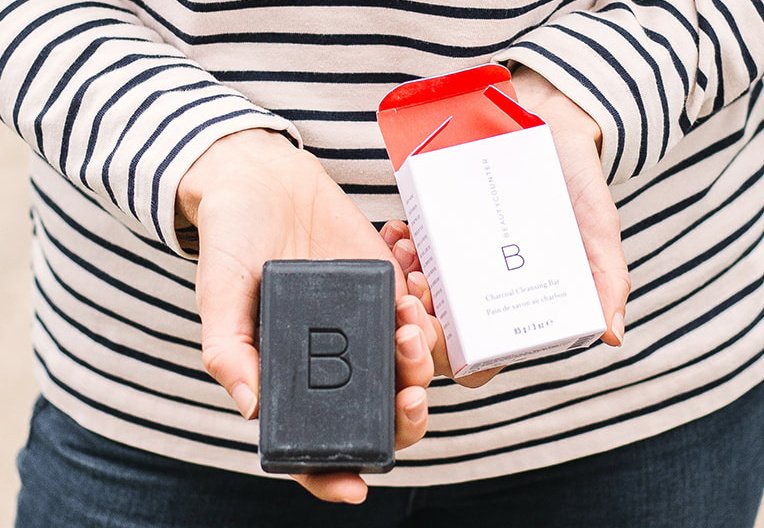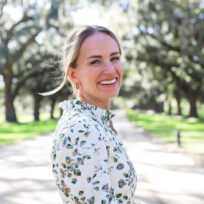


Beautycounter has been discontinued! Read about what happened to Beautycounter (and when it might come back) here. In the meantime, I have lots of great recommendations for Beautycounter product swaps linked in this post. Also, be sure to join my email list so you can be the first to know when your Beautycounter favorites come back.
If you’ve been reading my blog for a while, you know I LOVE Beautycounter. I now own almost all of their products, even though I was hesitant to try their skincare at first. But, I got hooked on their Dew Skin Tinted Moisturizer and that led me down a path of slowing transitioning nearly all my makeup, hair and body care products to safer options. And yes, I finally switched my skincare to Beautycounter too.
One of the things I love most about Beautycounter is that they’re transparent about what ingredients they use in all of their products. They’re also transparent about what ingredients they will NEVER use, even if nearly every other brand in the market does. But, with the latest investment by the Carlyle Group and Beautycounter’s $1 billion valuation, the beauty industry is sure to take note of what consumers want — and that’s better ingredients and more transparency.
I switched to Beautycounter and other safe brands (like Primally Pure and Branch Basics) once I learned what was in the products I was using (including high-end brands and some drugstore ones). I truly had no idea the harmful things I was putting on my body every single day. And I consider myself very well versed on making healthy choices!

Beautycounter has a “Never List” which is comprised of 2,800 ingredients questionable or harmful chemicals that they never use as ingredients in their products.
This includes the nearly 1,700 chemicals banned or restricted in personal care products by the European Union, plus additional chemicals screened by Beautycounter and found to be of concern. It says a lot of that there are more than 1,000 other ingredients Beautycounter won’t use.
Sadly, most of the ingredients on the Never List are are allowed and very regularly used in the United States. The EU is much more stringent than the US when it comes to personal care product safety. And Beautycounter takes it a step further and bans even more ingredients than the EU.

Using the Never List to evaluate your current skincare products is a great place to start if you want to start to use safer beauty products. Some people switch once they learn what’s actually in the brands they thought were safe (even though recommended by their dermatologist). Others switch when they become pregnant and realize that their products aren’t safe for their baby. Others switch because they want to live a healthy lifestyle and realize that healthy living goes beyond food and exercise. Skin care products can impact health too!
Honestly, some of this information is TERRIFYING and you can’t unlearn it. It’s hard to believe that this is even allowed. But Beautycounter is working to change it! It can be particularly challenging since many brands try to portray their products as safe products with clever packaging and marketing. But if you look closer, they’re not great options.
Below are some of the most commonly found ingredients in personal care products that Beautycounter will NEVER put into their products. I also included an explanation of what the ingredient is and why Beautycounter won’t use it.
This disinfectant is used as a preservative and has been associated with severe skin, eye, and respiratory irritation and allergies. It’s found in many sunscreens , moisturizers and other creams.
Butylated hydroxyAnisole and Butylated Hydroxytoluene
These are synthetic antioxidants used purely to extend shelf life. But they are likely carcinogens and hormone disruptors. They may also cause liver damage.
These are often found in lipsticks, moisturizers, diaper creams, and other cosmetics. I switched to Beautycounter lipsticks and lip glosses and LOVE them.

This is a byproduct of coal processing that is a known carcinogen. It is used as a colorant and an anti-dandruff agent and is found in hair dye and shampoo.
This chemical is a binding agent that is added to cosmetics to improve stability. Often used as a treatment for poisoning, EDTA may be toxic to organs and is found in hair coloring and moisturizers.
A preservative and surfactant linked to allergies, skin toxicity, hormone disruption, and inhibited fetal brain development. Because of its ability to decrease surface tension, this chemical is used in hair dyes, mascara, foundation, fragrances, sunscreens, dry-cleaning solvents, soaps, paint, and pharmaceuticals.
Used as a preservative in cosmetics, this known carcinogen is also linked to asthma, neurotoxicity, and developmental toxicity.
Formaldehyde is often found in shampoo, body wash, bubble bath and other shower products.
Hydroquinone
This skin-lightening chemical inhibits the production of melanin. And is linked to cancer, organ toxicity, and skin irritation. It’s predominantly found in skin-lightening creams that aim to reduce the coloring from freckles, age spots, chloasma, and melasma. (Beautycounter’s Overnight Peel and Vitamin C serum can help with these skin concerns without Hydroquinone.)
These chemical preservatives are among the most common irritants, sensitizers, and causes of contact skin allergies.
These chemicals are often found in liquid cosmetics, hair color, body wash, lotion, sunscreen, mascara, shaving cream, baby lotion, baby shampoo, hairspray, makeup remover, liquid soaps, and detergents.
This sunscreen agent is used as an ultraviolet light absorber. Oxybenzone is linked to irritation, sensitization, and allergies, and possible hormone disruption. It has also been known to be hazardous to the oceanic environment including coral reefs. The state of Hawaii has banned the use of sunscreen products containing oxybenzone starting in 2021.
This product is found in sunscreen, hair sprays, cosmetic products, and moisturizers. I use Beautycounter’s lotion and stick sunscreen for my body and CounterSun Daily Sheer or Dew Skin for my face SPF, every single day. They both use non-nano zinc, a mineral-based physical sunscreen, instead of oxybenzone.
Parabens are artificial preservatives in cosmetic and body care products. And commonly used to prevent the growth of bacteria and mold. What’s particularly concerning is that parabens are endocrine (or hormone) disruptors. Which may alter important hormone mechanisms in our bodies. For instance, parabens have been shown to mimic estrogen and when our bodies detect too much estrogen, this can trigger an increase in breast cell division. And growth of tumors directly linking it to breast cancer and reproductive issues.
Parabens can be found in shampoos, face cleansers, body wash, body lotions, and foundations. This is a VERY common ingredient. But it is, thankfully, becoming easier to find paraben-free products.
This industrial chemical is used to make products more pliable or to make fragrances stick to skin. Phthalates disrupt the endocrine system and may cause birth defects.
This chemical is found in synthetic fragrances like perfumes, nail polish, hairspray, soaps, aftershave lotion, and plastic materials.
PEGs are petroleum-derived compounds widely used in cosmetics as thickeners, solvents, softeners, and moisture-carriers. Depending on manufacturing processes, PEGs may be contaminated with measurable amounts of carcinogens that are linked to cancer.
PEGs are found in creams, sunscreen, and shampoo. Yuck factor PEGs are made from the main ingredient (ethylene glycol (ethane-1,2-diol)) in antifreeze. Yuck.
Retinyl palmitate is an ingredient composed of palmitic acid and retinol (Vitamin A). Data from an FDA study indicate that retinyl palmitate, when applied to the skin in the presence of sunlight, may result in adverse health consequences like lesions and photosensitization. FDA, Norwegian and German health agencies have raised a concern that daily skin application of vitamin A creams may contribute to excessive vitamin A intake for pregnant women and other populations.
Retinyl palmitate is often found in anti-aging creams, e.g. retin-A and retinol products. I stopped using my retinol product and replaced it with the Overnight Resurfacing Peel.

SLS and SLES are surfactants that can cause skin irritation or trigger allergies related to eyes, skin, mouth, and lungs. SLES is often contaminated with 1,4-dioxane, a byproduct of a petrochemical process called ethoxylation, which is used to process other chemicals in order to make them less harsh.
SLS and SLES are found in shampoo, body wash, bubble bath, conditioner, hair dye, dandruff treatment, and styling gel. They are also found in shaving cream, lip balm, hand sanitizer, nail treatments, makeup remover, foundation, facial cleansers, exfoliants, and liquid hand soap.
These engineered or lab-made scents or flavoring agents may contain any combination of 3,000-plus stock chemical ingredients, including hormone disruptors and allergens. So when people say they’re allergic to “fragrance”, it’s not just scent – they’re allergic to something that is labeled “fragrance” but you don’t actually know what that is.
Fragrance formulas are protected under federal law’s classification of trade secrets and therefore can remain undisclosed. That means we have no way of knowing what other chemicals or ingredients are used in these flavors or fragrances. I use Branch Basics for this reason. It’s so hard to find a fragrance-free AND paraben free laundry detergent!
Found in: all types of cosmetics, laundry detergents, body products, hair products, EVERYTHING. You may be able to find paraben-free products. But it’s very hard to find truly fragrance-free products that are also paraben free. If you start with just one switch, look for products that don’t include “fragrance” or “parfum” in their ingredient list.
This volatile petrochemical solvent is extremely toxic to the immune system and can cause birth defects. And irritation or damage to the skin, eyes, and respiratory tract. It’s also a highly flammable agent.
Toluene is found in nail polish, nail treatment, and hair dyes. I use Dazzle Dry for at-home manicures.
Antimicrobial pesticides are toxic to the aquatic environment and may also impact the human reproductive systems. It’s found in liquid soaps, soap bars, and toothpaste. I use Beautycounter Body Wash and the Charcoal Bar in the shower and keep their hand soap at EVERY sink in our house.

The moral of this post is for you to 1) pay attention to the ingredients that are in your skincare regimen and each cosmetic product you use, and 2) consider switching over to Beautycounter products or another safe, transparent brand. The EWG Skin Deep app is a great place to start to evaluate the products you currently use.
I’d encourage you to go look at 2-3 products you currently use and see what’s on the label. If you don’t have the label on the container anymore, google the product! And if you want to prioritize, a good place to start is replacing anything you use on your entire body daily (e.g. body wash or body lotion). Or, you could work to replace anything that contains parabens and/or fragrance.
If you want help choosing the right products for you, fill out my quick skincare survey and I’ll email you back!


Leave a Comment
2 responses to “Beautycounter Never List: what it is and why you should read it”
What is the primally pure oil that is photographed, and where does it fit into your regimen? I LOVE the primally pure deodorant, chapstick, and bug spray, btw!
It’s their plumping serum and I use it at night 1-2x a week under my Beautycounter Supreme Cream!